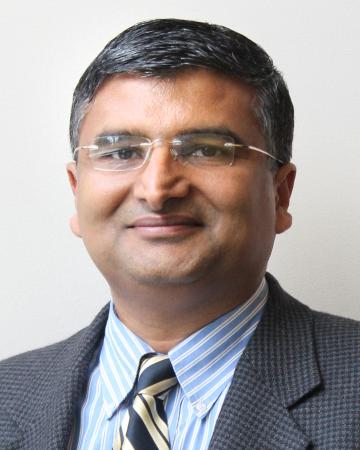Jaydev Desai, a professor in the Wallace H. Coulter Department of Biomedical Engineering at Georgia Tech and Emory University (BME) and director of the Georgia Center for Medical Robotics (GCMR), has spent his career developing robotic tools to address challenging clinical problems. And the National Institutes of Health (NIH) has taken notice.
Through the years, Desai has secured several NIH R01 grants to support his work in this area, but recently the Institutes not only stepped up to support Desai’s latest project (which can fill a critical gap in the treatment of deadly atherosclerosis), it also ranked the researcher’s grant application with its highest degree of confidence – a one percentile score.
“That is highly encouraging,” Desai says. “It clearly demonstrates how critical and challenging the clinical problem is and why innovative engineering solutions need to be developed to address it.”
The NIH’s National Heart, Lung, and Blood Institute (NHLBI) awarded a $2.8 million grant to support Desai’s lab and his collaborators for an innovative project that features the first use of intravascular steerable robotic guidewire capable of forward-looking ultrasound imaging and image-guided navigation through vasculature and occluded vessels.
Desai explains that the ability to steer, visualize, and navigate the guidewire is highly novel and will eventually result in improvement of clinical workflow and patient treatment outcomes. “Think of a plumber’s snake,” Desai says. “And this is all about steering the tip of the long snake with visualization of where to go with ultrasound imaging.”
Desai’s collaborators include Brooks Lindsey (Coulter Department), Stanislav Emelianov (Coulter Department and School of Electrical and Computer Engineering), and from Emory, Muralidhar Padala (cardiothoracic surgery), Khusrow Niazi (interventional cardiology) and Zachary Bercu (interventional radiology).
Patients with atherosclerosis can develop a buildup of fatty deposits, or plaque, within their arteries. These can lead to total blockages in the arteries, a condition called chronic total occlusion (CTO), which are the riskiest and most challenging vascular lesions to treat with traditional stenting or endovascular devices. The structure of the lesion (including a fibrous, calcific plaque) presents a complex technical challenge – the stiff formation can bend guidewire tips. Even successful procedures, Desai points out, “are time consuming, involve chance, and require prolonged patient and physician exposure to radiation.”
“The clinical challenge is well recognized in the community,” he adds. “Since endovascular approaches are increasingly utilized over conventional approaches, there is an urgent need to develop new technologies to meet this critical need!”
So Desai’s team plans to address three specific aims:
• Design and develop a robotically steerable, 0.014-inch diameter guidewire (0.355 mm) system to accommodate a .350 mm x .350 mm ultrasound transducer at its tip, and can be steered with image feedback from the transducer.
• Design and build a forward-looking transducer for the robotically steerable guidewire and an algorithm to reconstruct an image of the encountered occlusion.
• Iteratively optimize the ultrasound-steerable guidewire design using 3D printed, patient-specific models of CTOs, realistic human cadaver limbs with CTO, and a live animal model of CTOs.
The highly interdisciplinary project combines expertise in medical robotics, ultrasound imaging, pulsatile flow models and image-guided interventions in animal models, interventional cardiology, and interventional radiology. The designed system, Desai says, “will have significant societal impact through improved patient outcomes, reduced radiation exposure for the physician and the patient, reduced rate of procedural failures, and lower healthcare costs.”
Media Contact
Jerry Grillo
Communications Officer II
Parker H. Petit Institute for
Bioengineering and Bioscience
Keywords
Latest BME News
Jo honored for his impact on science and mentorship
The department rises to the top in biomedical engineering programs for undergraduate education.
Commercialization program in Coulter BME announces project teams who will receive support to get their research to market.
Courses in the Wallace H. Coulter Department of Biomedical Engineering are being reformatted to incorporate AI and machine learning so students are prepared for a data-driven biotech sector.
Influenced by her mother's journey in engineering, Sriya Surapaneni hopes to inspire other young women in the field.
Coulter BME Professor Earns Tenure, Eyes Future of Innovation in Health and Medicine
The grant will fund the development of cutting-edge technology that could detect colorectal cancer through a simple breath test
The surgical support device landed Coulter BME its 4th consecutive win for the College of Engineering competition.








